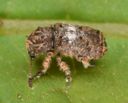Platystomini
Platystomini
Classification
- Phylum: Arthropoda
- Subphylum: Hexapoda
- Class: Insecta
- Order: Coleoptera
- Suborder: Polyphaga
- Superfamily: Curculionoidea
- Family: Anthribidae
- Subfamily: Anthribinae
- Tribe: Platystomini
Pronunciation
How to pronounce Platystomini: //ˌplætɪˈstɒmɪnaɪ//
These audio files are automatically generated. While they are not always 100% accurate, they are a good starting point.
Images




Summary
Platystomini is a tribe of fungus weevils in the beetle family Anthribidae, notable for their association with fungi and diverse morphology across genera.
Physical Characteristics
Platystomini members exhibit a variety of sizes and colors, often characterized by their elongated bodies and often robust form. Many have distinctive patterns and textures on their exoskeletons.
Identification Tips
Look for characteristic features such as a tapered snout and the unique shape of the body which can vary significantly among genera. Examining the antennae, which are typically elbowed, can also aid in identification.
Habitat
Typically found in forested or tropical environments where fungal growth is prevalent, often residing on or near decaying wood or other organic matter.
Distribution
Primarily tropical worldwide, with 4 genera represented in North America, and a total of 27 genera distributed globally.
Diet
Fungus weevils primarily feed on fungi, especially wood-decaying fungi, which they use for both nourishment and as breeding sites.
Life Cycle
Life cycles include distinct larval and adult stages. Larvae typically develop within the fungal substrate, contributing to the breakdown of organic material.
Reproduction
Reproduction typically occurs within fungal growth where females lay eggs, and larvae feed on the associated fungi as they develop.
Predators
Natural predators include various birds, mammals, and other insect species that may feed on adults or larvae.
Ecosystem Role
As decomposers, they play a crucial role in breaking down fungi and aiding nutrient cycling within their ecosystems.
Economic Impact
Limited economic impact; however, some species may be indicators of environmental health due to their association with fungal habitats.
Collecting Methods
- Light trapping during night
- Manual collection from decaying wood or fungal growths
Preservation Methods
- Drying
- Pinning specimens
- Storing in alcohol
Evolution
Platystomini evolved alongside diverse fungal lineages, showcasing adaptations for using fungi as both food and habitat.
Similar Taxa
- Curculionoidea
- Anthribidae
- Bolyphinae
- Bolyphus
Misconceptions
Often confused with other weevil families due to morphological similarities, leading to misidentification.
Tags
- beetles
- fungus weevils
- Platystomini
- insecta
- biodiversity